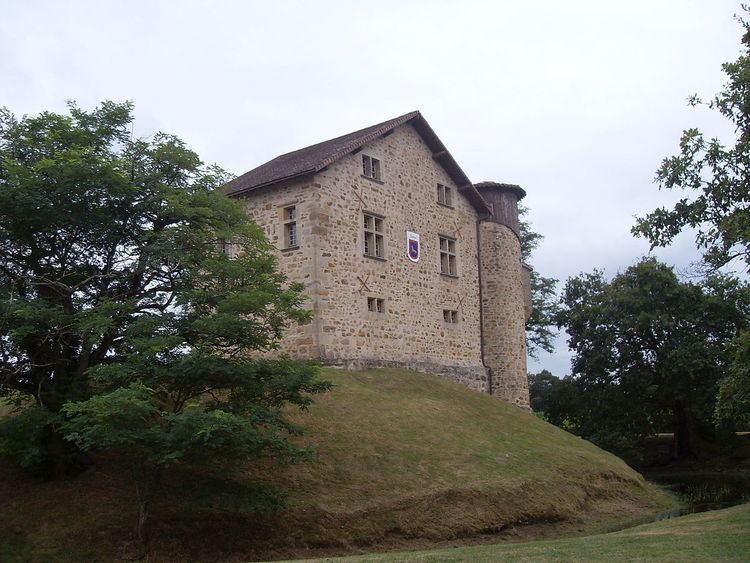Population (2014) 671 Local time Sunday 6:39 PM | Intercommunality Pays Basque Area 9.6 km² | |
 | ||
Canton Pays de Bidache, Amikuze et Ostibarre Weather 14°C, Wind N at 8 km/h, 70% Humidity | ||
Aïcirits-Camou-Suhast (Basque: Aiziritze-Gamue-Zohazti) is a commune in the Pyrénées-Atlantiques department in the Nouvelle-Aquitaine region in southwestern France.
Contents
- Map of 64120 AC3AFcirits Camou Suhast France
- Fuite d tecter infiltration d g ts des eaux a cirits camou suhast
- Location
- Hydrography
- Toponymy
- History
- Administration
- Administrative Associations
- Judicial Districts
- Inter communality
- Demography
- Economy
- Languages
- Civil heritage
- Religious Heritage
- Notable People linked to the commune
- References
Map of 64120 A%C3%AFcirits-Camou-Suhast, France
The people of the commune are known as Aiziriztar.
Fuite d tecter infiltration d g ts des eaux a cirits camou suhast
Location
The commune is part of the Mixe country in the French Basque Country of Lower Navarre. It is located immediately north of Saint-Palais. Highway D29 runs north from Saint-Palais through the entire commune from south to north and passing through the town. The D529 Highway runs east from the commune to its junction with Highway D134. Highway D933 enters the commune in the southeast and runs north along the eastern side of the commune to exit in the north.
Hydrography
The commune is located in the Drainage basin of the Adour and is watered by the Bidouze, a tributary of the Adour, and it has its tributaries: the Joyeuse and the Eyherachar and Recalde streams.
Toponymy
The commune's name in Basque is Aiziritze-Gamue-Zohazti.
For Aïcirits, Jean-Baptiste Orpustan proposed the Basque etymology aitz, meaning "high" and aratze, meaning "fern patch", giving "high fern patch" or "rocky fern patch".
He also indicated that Suhast may come from zuhaztoi, meaning "plantation of trees".
The inhabitants of Camou are known as Gamuar and the inhabitants of Suhast are known as Zohaztiar.
The following table details the origins of the commune name and other names in the commune.
Sources:
Origins:
History
Suhast, formerly the village of Camou-Mixe, joined Aïcirits and Camou-Mixe on 22 March 1842.
Administration
List of Successive Mayors of Aïcirits-Camou-Suhast
(Not all data is known)
Administrative Associations
The commune is linked to the following administrative bodies (non exhaustive list):
Judicial Districts
The town depends on the district court of Bayonne, the High Court of Bayonne and the Court of Appeal of Pau.
Inter-communality
The commune belongs to six inter-communal structures:
Demography
In 1350 there were 20 hearths in Camou.
The fiscal census of 1412 to 1413, made on the order of Charles III of Navarre, compared to the one in 1551 "of men and weapons that are in the kingdom of Navarre outside the ports", revealed a strong growth in population. The first census indicated at Aïcirits the presence of 4 fires, the second 13 fires (12 + 1 secondary fire). Similarly in Camou, the census reported in 1412-1413 10 fires, and that of 1551 31 fires (27 + 4 secondary fires). Finally at Suhast, the counts indicated 6 fires in the first census and 22 fires (21 + 1 secondary fire) for the second.
The census of the population of Lower Navarre in 1695 returned Aïcirits with 31 fires, Camou with 49, and Suhast with 38.
In 2010, the commune had 655 inhabitants. The evolution of the number of inhabitants is known through the population censuses conducted in the town since 1793. From the 21st century, a census of municipalities with fewer than 10,000 inhabitants is held every five years, unlike larger towns that have a sample survey every year.
Sources : Ldh/EHESS/Cassini until 1962, INSEE database from 1968 (population without double counting and municipal population from 2006)
Prior to 1842 the above tables are only for the Camou-Mixe commune. Before that date, Suhast's population was as follows:
Economy
Aïcirits-Camou-Suhast is classified by the INSEE among the communes which are predominantly rural areas in the hilly agricultural region of the Basque Country. It is part of a favoured agricultural area known as "simple" (under rules of the Ministry of Agriculture, Food, Fisheries and Rural Affairs).
The registered office of the Lur Berri company, a large food cooperative group, is located in Aïcirits-Camou-Suhast.
The town is part of the designated zone of Ossau-iraty.
It also hosts other companies in the agri-food sector as one of the first fifty two communes of the department:
Languages
According to the Map of the Seven Basque Provinces published in 1863 by Prince Louis-Lucien Bonaparte, the dialect of Basque spoken in Aicirits-Camou-Suhast is eastern low Navarrese.
The village has a cave at Camou (the grotto Oltzibarre) closely linked to the Basque legend of Txahalgorri, the young red bull.
